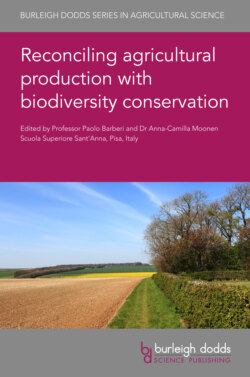Читать книгу Reconciling agricultural production with biodiversity conservation - Группа авторов - Страница 6
ОглавлениеContents
Part 1 Methods to study biodiversity in agroecosystems
1 The challenge of monitoring biodiversity in agricultural landscapes at the EU level
M. L. Paracchini, European Commission, Joint Research Centre (JRC), Italy; S. Condé, European Topic Centre on Biological Diversity – Muséum National d’Histoire Naturelle, France; R. D’Andrimont, European Commission, Joint Research Centre (JRC), Italy; B. Eiselt, European Commission, Eurostat, Luxembourg; O. Fernandez Ugalde, E. Gervasini and A. Jones, European Commission, Joint Research Centre (JRC), Italy; V. Kovacevic, European Commission, DG Environment, Belgium; R. Oppermann, Institut für Agrarökologie und Biodiversität (IFAB), Germany; A. Orgiazzi, M. Van der Velde, C. Polce and C. Rega, European Commission, Joint Research Centre (JRC), Italy; C. Van Swaay, De Vlinderstichting, The Netherlands; and P. Voříšek, Czech Society for Ornithology, Czech Republic
2Farmland birds and butterflies
6Monitoring under the Habitats Directive 92/43/EEC
7European Monitoring of Biodiversity in Agricultural Landscapes (EMBAL)
10New approaches and technologies
12Where to look for further information
2 Modelling biodiversity in agriculture
G. R. Squire, James Hutton Institute, UK
2Interaction among individuals for place, space or resource
3Process-based modelling
4Trading biophysical, economic, social and political currencies
5Whole-system multi-attribute decision modelling
6Future trends and conclusion
7Where to look for further information
8References
3 Assessing the economic value of agricultural biodiversity: a critical perspective
Corrado Topi, Stockholm Environment Institute at York, Department of Environment and Geography and Interdisciplinary Global Development Centre, University of York, UK; and Leonie J. Pearson, Stockholm Environment Institute, Thailand
1Introduction
2The relationship between definitions and economic approaches
3What does valuing agricultural biodiversity mean?
4The ecosystem services framework (ESF)
5Ecosystem interactions
6Understanding the limitations of ecosystem service valuations
7The investor perspective: the natural environment as a legally structured persona
8Conclusions
9References
4 Functional biodiversity for the provision of agroecosystem services
Paolo Bàrberi and Anna-Camilla Moonen, Institute of Life Sciences – Scuola Superiore Sant’Anna, Italy
1Introduction
2The rise of studies on agriculture: biodiversity relationships
3Functional biodiversity and the delivery of agroecosystem services
4How can research contribute to the advancement of functional agrobiodiversity?
5Where to look for further information
6References
Part 2 Management practices to support agroecosystem services
5 The role of field margins in biodiversity conservation in agroecosystems
Alicia Cirujeda and Gabriel Pardo, Centro de Investigación y Tecnología Agroalimentaria de Aragón (CITA-Universidad de Zaragoza), Spain
1Introduction
2Options for promoting biodiversity in agricultural landscapes
3Field margins: characteristics and types
4The role of field margins in agroecosystems
5Managing field margins to promote insect biodiversity
6Managing field margins to promote rare arable plants, reptiles, amphibians, birds and mammals
7Conclusions
8Where to look for further information
9References
6 The role of hedgerows in supporting biodiversity and other ecosystem services in intensively managed agricultural landscapes
Audrey Alignier, Léa Uroy and Stéphanie Aviron, INRAE, France
1Introduction
2What is a hedgerow?
3The role of hedgerows as habitat for biodiversity
4Hedgerows as managed elements
5Hedgerows as part of farming systems
6Case study: hedgerow plantation and bocage restoration enhance biodiversity and other ecosystem services
7Summary and future trends
8Where to look for further information
9References
7 Reconciling production and biodiversity in management of pastures and grasslands
Sylvain Plantureux, Université de Lorraine, INRAE, LAE, France
1Introduction
2Analyzing the relationship between biodiversity and productivity in grasslands
3Biodiversity factors affecting grassland productivity
4Biodiversity factors affecting grassland productivity over time
5Biodiversity factors affecting the quality of forage and animal products
6Grassland biodiversity and ecosystem services
7Assessing the economic value of species-rich grasslands
8Management of grasslands for both biodiversity and production
9Case study: flowering meadows competition
10Summary and future trends
11References
8 The importance of agroforestry systems in supporting biodiversity conservation and agricultural production a European perspective
M. R. Mosquera-Losada, J. J. Santiago-Freijanes, A. Rigueiro-Rodríguez, F. J. Rodríguez-Rigueiro, D. Arias Martínez, A. Pantera and N. Ferreiro-Domínguez, University of Santiago de Compostela, Spain
1Introduction
2The contribution of agroforestry to global biodiversity goals
3Agroforestry and the protection of species and habitats
4Agroforestry and the maintenance and restoration of ecosystems
5Achieving more sustainable agriculture and forestry
6Stopping the loss of global biodiversity
7Future trends
8Where to look for further information
9Acknowledgements
10References
Index
